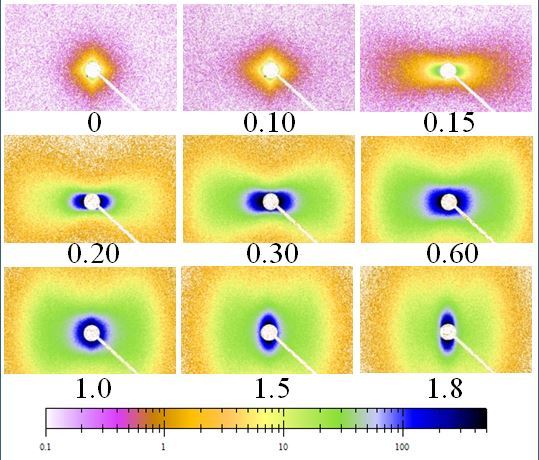During the industrial transformation, most polymers are involved in specific processes resulting in the macromolecular chain orientation. Such orientation is appearing from the local phase to the mesophase and sometimes even up to the macroscopic phase.
Small Angle X-Ray Scattering (SAXS) is a technique well suited for investigating nano-materials and nano-structures of polymers. Information is collected on sample structure parameters such as particle shape or size, size distribution, orientation, surface to volume ratio… in the range from 1 nm to beyond 100 nm. Moreover, orientational functions can be derived from 2 dimensional x-ray patterns. Length-scales down to 0.1 nm can also be investigated in combination with Wide Angle X-ray Scattering (WAXS). In the case of samples with internal structures larger than 200 nm, USAXS (Ultra Small Angle X-Ray scattering) experimental conditions are required. USAXS allows to access heterogeneities about some hundreds of nanometers while providing the opportunity to investigate the large-scale structure evolution during the deformation of polymeric materials [1]. The progress in the performances of x-ray components and subsequent assembly offers such characterization methods in the laboratory. Hence, investigation of an injected semicrystalline polymer has been performed, emphasizing the nanostructure orientation and processing relationships. Further, recent results obtained on in-situ stretched Polybutene-1 (PB-1) [Figure 1] illustrate the capability to perform lab measurement equivalent to Synchrotron USAXS [2] highlighting microscopic structural evolution and macroscopic strain-whitening phenomenon correlation.

Figure 1: 2D-USAXS patterns of PB-1 crystallized at 60oC stretched at 30oC as a function of engineering strain - 50s exposure time. Stretching direction horizontal. Data courtesy of Pr. Men and Y. Wang.
References
[1] - Y. Men et al, Macromolecules 37, 9481 (2004)
[2] - Y. Men et al, under submission (2013) |